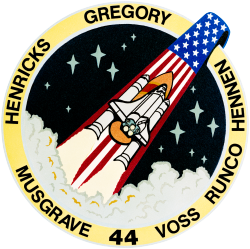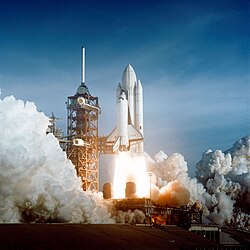STS-44
| Missionsemblem | |||
|---|---|---|---|
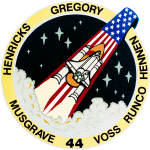 | |||
| Missionsdaten | |||
| Mission | STS-44 | ||
| NSSDCA ID | 1991-080A | ||
| Besatzung | 6 | ||
| Start | 24. November 1991, 23:44:00 UTC | ||
| Startplatz | Kennedy Space Center, LC-39A | ||
| Landung | 1. Dezember 1991, 22:34:44 UTC | ||
| Landeplatz | Edwards Air Force Base, Bahn 05 | ||
| Flugdauer | 6d 22h 50m 44s | ||
| Erdumkreisungen | 110 | ||
| Bahnhöhe | 365 km | ||
| Bahnneigung | 28,5° | ||
| Zurückgelegte Strecke | 4,7 Mio. km | ||
| Mannschaftsfoto | |||
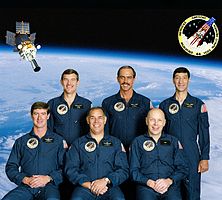 v. l. n. r. Terence Henricks, James Voss, Frederick Gregory, Thomas Hennen, Story Musgrave, Mario Runco | |||
| ◄ Vorher / nachher ► | |||
| |||
STS-44 (englisch Space Transportation System) ist eine Missionsbezeichnung für das US-amerikanische Space Shuttle Atlantis (OV-104) der NASA. Der Start erfolgte am 24. November 1991. Es war die 44. Space-Shuttle-Mission und der zehnte Flug der Raumfähre Atlantis.
Mannschaft
Hauptmannschaft
- Frederick Gregory (3. Raumflug), Kommandant
- Terence Henricks (1. Raumflug), Pilot
- Story Musgrave (4. Raumflug), Missionsspezialist
- Mario Runco (1. Raumflug), Missionsspezialist
- James Voss (1. Raumflug), Missionsspezialist
- Thomas Hennen (1. Raumflug), Nutzlastspezialist, United States Army
Ursprünglich war David Walker als Kommandant vorgesehen. Im Juli 1990 wurde er aufgrund eines Luftzwischenfalls vom Mai 1989 dieses Amtes enthoben und durch Gregory ersetzt.[1] Gregory und Musgrave waren bereits bei STS-33 gemeinsam im All gewesen.
Ersatz
- Michael Belt für Hennen
Missionsüberblick
Der Start war zuerst für den 19. November geplant gewesen, wurde aber wegen eines defekten Trägheitssensors der Antriebsstufe eines Defense Support Program-Satelliten (DSP) verschoben. Die Einheit wurde ausgetauscht und getestet, der Start anschließend für den 24. November angesetzt. Er musste nochmals um 13 Minuten verschoben werden, um einem Raumschiff im Orbit den sicheren Vorbeiflug zu erlauben und um den externen Flüssigsauerstofftank vollzutanken, nachdem kleinere Reparaturen daran erfolgt waren. Das Startgewicht betrug 117.766 kg.
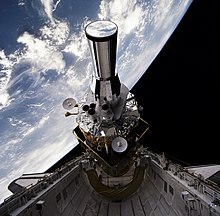
Es war eine Mission für das Department of Defense (US-Verteidigungsministerium). Die nicht geheime Nutzlast enthielt den Defense Support Program Satelliten und dessen Inertial Upper Stage (IUS), welcher am ersten Flugtag ausgesetzt wurde. Weitere Nutzlasten in der Nutzlastbucht und am Mitteldeck waren Interim Operational Contamination Monitor (IOCM), Terra Scout, Military Man in Space (M88-1), Air Force Maui Optical System (AMOS), Cosmic Radiation Effects and Activation Monitor (CREAM), Shuttle Activation Monitor (SAM), Radiation Monitoring Equipment III (RME III), Visual Function Tester-1 (VFT-1), Ultraviolet Plume Instrument (UVPI), Bioreactor Flow and Particle Trajectory experiment und Extended Duration Orbiter Medical Project.
Die Landung erfolgte am 1. Dezember 1991 um 14:34:44 PST auf Landebahn 5, Edwards Air Force Base, Kalifornien. Der Ausrollweg betrug 11.191 Fuß, die Ausrollzeit 107 Sekunden. Die Landung war eigentlich für den 4. Dezember geplant gewesen, wurde jedoch am 30. November vorverlegt, nachdem ein Fehler in einem der drei Trägheitssensoren des Orbiters festgestellt worden war. Bei der Landung wurde zu Testzwecken nur minimal gebremst, was den langen Ausrollweg erklärt. Der Orbiter kehrte am 8. Dezember in das Kennedy Space Center zurück. Das Landegewicht betrug 87.918 kg.
Siehe auch
Weblinks
- NASA-Missionsüberblick (englisch)
- Videozusammenfassung mit Kommentaren der Besatzung (englisch)
- STS-44 in der Encyclopedia Astronautica (englisch)
- Michael Cassutt: Secret Space Shuttles (englisch)
Einzelnachweise
- ↑ NASA: Shuttle Crew Commanders Reassigned. (PDF) In: NASA Release 90-037. 9. Juli 1990, archiviert vom (nicht mehr online verfügbar) am 7. Mai 2021; abgerufen am 24. September 2020 (englisch). Info: Der Archivlink wurde automatisch eingesetzt und noch nicht geprüft. Bitte prüfe Original- und Archivlink gemäß Anleitung und entferne dann diesen Hinweis.
Auf dieser Seite verwendete Medien
STS-44 Mission Insignia
The April 12 launch at Pad 39A of STS-1, just seconds past 7 a.m., carries astronauts John Young and Robert Crippen into an Earth orbital mission scheduled to last for 54 hours, ending with unpowered landing at Edwards Air Force Base in California.
The STS-44 crew portrait includes 6 astronauts. Pictured seated, from left to right, are Terence T. Hendricks, pilot; Frederick D. Gregory, commander; and F. Story Musgrave, mission specialist. Standing on the back row (left to right) are James S. Voss, mission specialist; Thomas J. Hennen, payload specialist; and Mario Runco, Jr., mission specialist. The 6 crew members launched aboard the Space Shuttle Atlantis on November 24, 1991 at 6:44:00 pm (EST). Dedicated to the Department of Defense (DOD), the mission's primary unclassified payload was the Defense Support Program (DSP) satellite and attached Inertial Upper Stage (IUS).
STS-44 Defense Support Program (DSP) / Inertial Upper Stage (IUS) spacecraft, with forward airborne support equipment (ASE) payload retention latch actuator released (foreground), is raised to a 29 degree predeployment position by the ASE aft frame tilt actuator (AFTA) table in the payload bay (PLB) of Atlantis, Orbiter Vehicle (OV) 104. Underneath the DSP / IUS combination, the umbilical boom is connected to the IUS. DSP components include Infrared (IR) sensor (top), AR I, SHF Antenna, EHF Antenna, Link 2 High-Gain Antenna, star sensor, and stowed solar paddles (box-like structure around the base). The Earth's limb and the blackness of space create the backdrop for this deployment scene.

